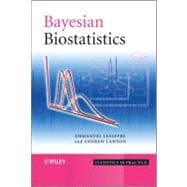
Note: Supplemental materials are not guaranteed with Rental or Used book purchases.
Purchase Benefits
What is included with this book?
Andrew Lawson, Professor of Statistics, Dept of Epidemiology & Biostatistics, University of South Carolina, USA. Dr Lawson has considerable and wide ranging experience in the development of statistical methods for spatial and environmental epidemiology. He has solid experience in teaching Bayesian statistics to students studying biostatistics and has also written two books and numerous journal articles in the biostatistics area. Dr Lawson has also guest edited two special issues of “Statistics in Medicine” focusing on Disease Mapping. He is a member of the editorial boards of the journals: Statistics in Medicine and .
Notation, terminology and some guidance for reading the book xvii
Part I BASIC CONCEPTS IN BAYESIAN METHODS
1 Modes of statistical inference 3
1.1 The frequentist approach: A critical reflection 4
1.2 Statistical inference based on the likelihood function 10
1.3 The Bayesian approach: Some basic ideas 14
1.4 Outlook 18
2 Bayes theorem: Computing the posterior distribution 20
2.1 Introduction 20
2.2 Bayes theorem – the binary version 20
2.3 Probability in a Bayesian context 21
2.4 Bayes theorem – the categorical version 22
2.5 Bayes theorem – the continuous version 23
2.6 The binomial case 24
2.7 The Gaussian case 30
2.8 The Poisson case 36
2.9 The prior and posterior distribution of h(θ) 40
2.10 Bayesian versus likelihood approach 40
2.11 Bayesian versus frequentist approach 41
2.12 The different modes of the Bayesian approach 41
2.13 An historical note on the Bayesian approach 42
2.14 Closing remarks 44
3 Introduction to Bayesian inference 46
3.1 Introduction 46
3.2 Summarizing the posterior by probabilities 46
3.3 Posterior summary measures 47
3.4 Predictive distributions 51
3.5 Exchangeability 58
3.6 A normal approximation to the posterior 60
3.7 Numerical techniques to determine the posterior 63
3.8 Bayesian hypothesis testing 72
3.9 Closing remarks 78
4 More than one parameter 82
4.1 Introduction 82
4.2 Joint versus marginal posterior inference 83
4.3 The normal distribution with μ and σ2 unknown 83
4.4 Multivariate distributions 89
4.5 Frequentist properties of Bayesian inference 92
4.6 Sampling from the posterior distribution: The Method of Composition 93
4.7 Bayesian linear regression models 96
4.8 Bayesian generalized linear models 101
4.9 More complex regression models 102
4.10 Closing remarks 102
5 Choosing the prior distribution 104
5.1 Introduction 104
5.2 The sequential use of Bayes theorem 104
5.3 Conjugate prior distributions 106
5.4 Noninformative prior distributions 113
5.5 Informative prior distributions 121
5.6 Prior distributions for regression models 129
5.7 Modeling priors 134
5.8 Other regression models 136
5.9 Closing remarks 136
6 Markov chain Monte Carlo sampling 139
6.1 Introduction 139
6.2 The Gibbs sampler 140
6.3 The Metropolis(–Hastings) algorithm 154
6.4 Justification of the MCMC approaches∗ 162
6.5 Choice of the sampler 165
6.6 The Reversible Jump MCMC algorithm∗ 168
6.7 Closing remarks 172
7 Assessing and improving convergence of the Markov chain 175
7.1 Introduction 175
7.2 Assessing convergence of a Markov chain 176
7.3 Accelerating convergence 189
7.4 Practical guidelines for assessing and accelerating convergence 194
7.5 Data augmentation 195
7.6 Closing remarks 200
8 Software 202
8.1 WinBUGS and related software 202
8.2 Bayesian analysis using SAS 215
8.3 Additional Bayesian software and comparisons 221
8.4 Closing remarks 222
Part II BAYESIAN TOOLS FOR STATISTICAL MODELING
9 Hierarchical models 227
9.1 Introduction 227
9.2 The Poisson-gamma hierarchical model 228
9.3 Full versus empirical Bayesian approach 238
9.4 Gaussian hierarchical models 240
9.5 Mixed models 244
9.6 Propriety of the posterior 260
9.7 Assessing and accelerating convergence 261
9.8 Comparison of Bayesian and frequentist hierarchical models 263
9.9 Closing remarks 265
10 Model building and assessment 267
10.1 Introduction 267
10.2 Measures for model selection 268
10.3 Model checking 288
10.4 Closing remarks 316
11 Variable selection 319
11.1 Introduction 319
11.2 Classical variable selection 320
11.3 Bayesian variable selection: Concepts and questions 325
11.4 Introduction to Bayesian variable selection 326
11.5 Variable selection based on Zellner’s g-prior 333
11.6 Variable selection based on Reversible Jump Markov chain Monte Carlo 336
11.7 Spike and slab priors 339
11.8 Bayesian regularization 345
11.9 The many regressors case 351
11.10 Bayesian model selection 355
11.11 Bayesian model averaging 357
11.12 Closing remarks 359
Part III BAYESIAN METHODS IN PRACTICAL APPLICATIONS
12 Bioassay 365
12.1 Bioassay essentials 365
12.2 A generic in vitro example 369
12.3 Ames/Salmonella mutagenic assay 371
12.4 Mouse lymphoma assay (L5178Y TK+/−) 373
12.5 Closing remarks 374
13 Measurement error 375
13.1 Continuous measurement error 375
13.2 Discrete measurement error 382
13.3 Closing remarks 389
14 Survival analysis 390
14.1 Basic terminology 390
14.2 The Bayesian model formulation 394
14.3 Examples 397
14.4 Closing remarks 406
15 Longitudinal analysis 407
15.1 Fixed time periods 407
15.2 Random event times 417
15.3 Dealing with missing data 420
15.4 Joint modeling of longitudinal and survival responses 424
15.5 Closing remarks 429
16 Spatial applications: Disease mapping and image analysis 430
16.1 Introduction 430
16.2 Disease mapping 430
16.3 Image analysis 444
17 Final chapter 456
17.1 What this book covered 456
17.2 Additional Bayesian developments 456
17.3 Alternative reading 459
Appendix: Distributions 460
A.1 Introduction 460
A.2 Continuous univariate distributions 461
A.3 Discrete univariate distributions 477
A.4 Multivariate distributions 481
References 484
Index 509
The New copy of this book will include any supplemental materials advertised. Please check the title of the book to determine if it should include any access cards, study guides, lab manuals, CDs, etc.
The Used, Rental and eBook copies of this book are not guaranteed to include any supplemental materials. Typically, only the book itself is included. This is true even if the title states it includes any access cards, study guides, lab manuals, CDs, etc.